Fencing
Fencing is a sport, the core of which is the conduct of combat using cold steel weapons (epees, foils, or sabers). Fencers need to hit an opponent and repel or avoid hits towards them.
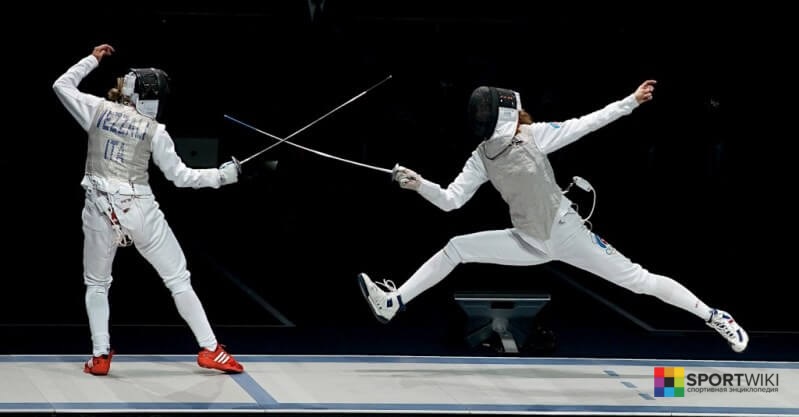
The International Fencing Federation was founded on November 29, 1913, in Paris. Nowadays, it resides in Lausanne (Switzerland).
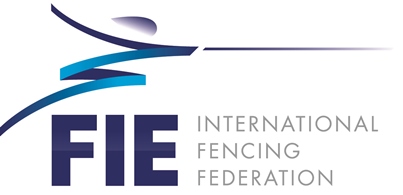
Contents
History of Fencing
Three thousand years ago, the Egyptian pharaoh Ramses III arranged a fencing tournament in honor of the victory over the Libyans. The frescoes of those times vividly depict weapons, which are very similar to the modern ones used in fencing, as well as face protection masks. In addition to Egypt, competitions were held in Ancient Greece, India, Rome, China, and Japan.
In the Middle Ages, representatives of the aristocracy of the feudal principalities and states were mainly engaged in fencing. Ordinary citizens and peasants fenced using iron-covered sticks or halberds.
Fencing as the art of wielding an epee and foil originated in Spain in the 15th century. At about the same time, a corporation of fencing instructors was created in Germany, and an association of fencers was established in England.
In the 16th century in Italy, the principles of fencing were defined for the first time. They were specified in the classification of techniques and actions. Italian instructors developed a fencing course and theoretically substantiated its principles. At this time, the types of weapons, the blade edge of which could penetrate into the gaps between the plates of armor, were gaining popularity. This circumstance was the reason why the sword blade became narrower closer to the edge and, ultimately, led to the occurrence of the epee, which finally totally replaced the sword. Spain was the birthplace of the foil with a handle of the classic type, having a cup guard.
The first fencing competitions (in their modern interpretation) were held in 1986, in Budapest.
On November 9, 1913, the International Fencing Federation was established in Paris. In 1914, the first international rules were defined. In 1921, the first international tournament was organized in Paris under its auspices, which later received World Championship status. The world championships of fencing using epees for men have been held since 1921, using sabers – since 1922, using foils – since 1926.
The first European Championship was held in 1981 under the auspices of the European Fencing Confederation, and the Fencing World Cup has been held since 1972.
Fencing Rules
Before starting the bout, the weapons should be checked for stiffness, length, presence of microcracks; the equipment and mask should be checked for endurance and electrical conductivity.
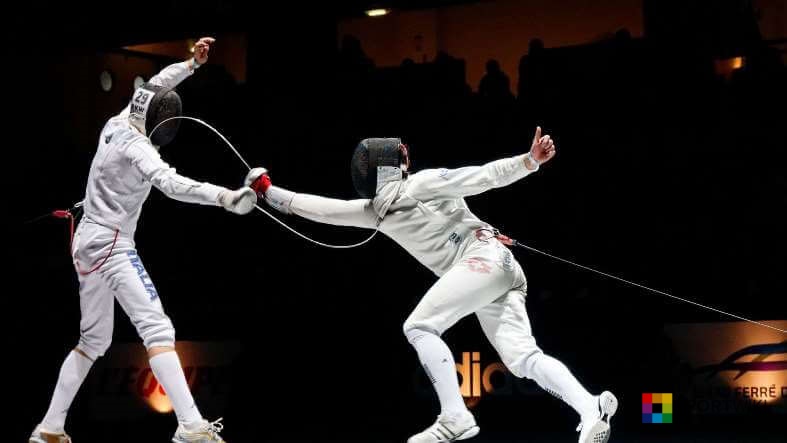
An athlete, who is the first to inflict a certain number of hits to the opponent or the first to inflict a greater number of hits in the allotted time, wins the bout. All hits are recorded by a special electronic system. A beep is heard and a special lamp lights up after the hit is recorded. The referee may fail to score a hit or a blow if it was performed with violation of rules. In case of epee fencers, the very fact of hitting is noted, while in case of foil fencers and saber fencers, a certain color shows whether the hit (blow) was inflicted on the affected surface.
Athletes are punished with penalty hits for crossing the rear border. Penalty hits are not assigned for crossing the side borders of the piste, but the bout is stopped, and the inflicted hits are canceled. Another penalty hit can be received if the bodies collide. In this case, the athlete responsible for the collision is punished.
Fencing piste
The fencing piste is 14 meters long and 1.5 to 2 meters wide. It is made of conducting material and is insulated from the system, which records hits and blows. The following marking is drawn on the piste:
- centerline;
- 2 lines of the starting position (at the distance of 2 meters from the center line);
- side borders of the piste;
- rear borders of the piste.

Two-meter stretches are marked (across the entire width) on each side of the piste. They warn the retreating athlete that s/he is dangerously close to his rear border.
Fencing Sports Equipment
The fencer's protective outfit consists of a jacket and knee-length trousers with suspenders made of lightweight kevlar. Athletes wear long white stockings and special fencing shoes with a flat sole. The athlete’s head is protected by a mask with a metal mesh; a collar protects the athlete’s throat, correspondingly. They have gloves on their hands. Fencers put on protective plastrons under a protective suit.
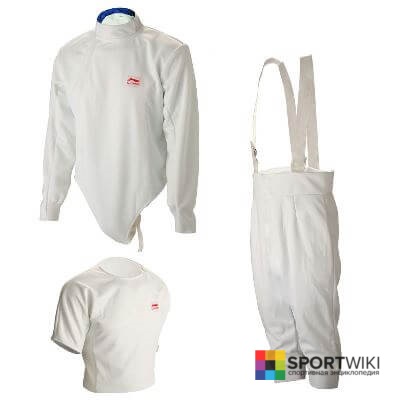
The mask mesh of epee fencers is insulated with plastic shock-resistant material from inside and outside. The masks of foil fencers are similar to the masks of epees, but they have an additional electric collar. The mask mesh and the collar of saber fencers are not insulated and are made of conducting material. Saber glove has a conductive cuff.
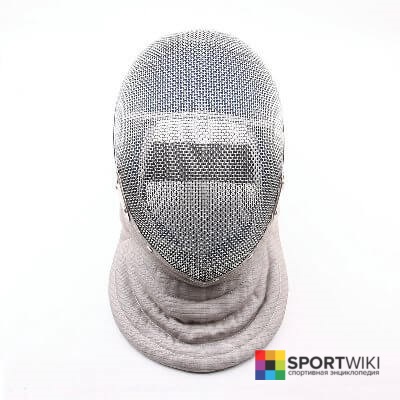
Foil fencers wear special metalized conducting vests over the suit, and saber fencers wear jackets that reflect the athlete’s affected surface.
Fencing types of swords:
- Foil is a thrusting cold steel weapon with a flexible blade. The length of the foil varies from 90 to 110 centimeters, and the weight of the foil is 500 grams. The foil has a guard with a diameter of 12 centimeters to protect the hands of athletes.
- Epee is a thrusting cold steel weapon. It is very similar to the foil as regards design. Unlike the foil, the epee has a stiffer blade (a triangular cross-section) and it is 270 grams heavier. The guard, protecting the hands of athletes, is 13.5 centimeters in diameter.
- Saber is a cutting and thrusting cold steel weapons of the trapezoidal section up to 105 cm long and weighing 500 g
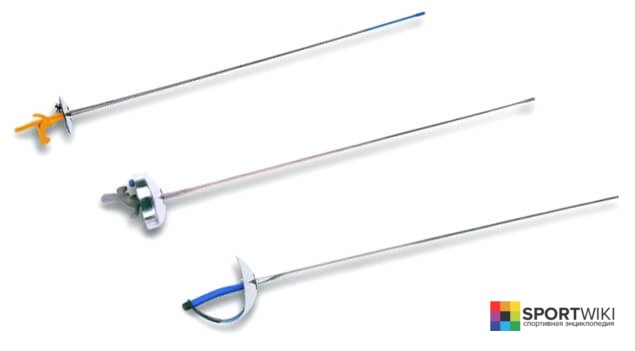
Fencing refereeing
Fencing refereeing is traditionally conducted in French. All fencing bouts are conducted by the referee who has a national or international referee certificate. His/her duties are as follows:
- calling participants;
- checking equipment before the bout;
- monitoring the proper operation of the device;
- supervising other officials (assistants, timekeepers, secretaries, etc.);
- punishing athletes for violation of rules;
- maintaining order.
The referee performs his/her duties with the help of an automatic hit recorder and two assistants, who monitor the use of the unarmed hand, covering the affected surface, hits inflicted into the floor when fencing using epees, crossing the side and rear borders of the bout field and all other violations provided by the Rules .
Assistants of the referee settle at the opposite ends of the fencing piste. Their duties include monitoring the overall course of the bout. The assistants should switch sides after each period in the bouts of the direct elimination tour and after each bout in the team meeting.
Fencing competitions
- Olympic Games.
- World Fencing Championship is an annual international competition with the use of foils, epees, and sabers.
- World Fencing Cup is an annual international fencing competition, which is held under the auspices of the International Fencing Federation. A series of tournaments are held during the season. Points are scored for each place in a particular tournament. Ultimately, they are added together.
- National Championships.

